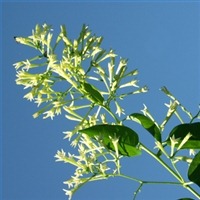 Common or poet’s jasmine (Jasminum officinale) is the classic, sweet-smelling jasmine that blooms all summer. Its memorable, exotic scent accompanies a semi-vining shrub. Cultivate it as a fast-growing vine by encouraging young vines–tie them to a trellis or other support–or as a shrub by pruning and shaping the plant regularly, or by allowing it to develop naturally as a rounded mound. Other jasmines come in a variety of forms, and may or may not have scented flowers. Gardeners often are surprised to discover that dark-green star jasmine or confederate jasmine, with its sweet nutmeg-scented flowers, isn’t a true jasmine but instead is from the Trachelospermum jasminoides species.
Common or poet’s jasmine (Jasminum officinale) is the classic, sweet-smelling jasmine that blooms all summer. Its memorable, exotic scent accompanies a semi-vining shrub. Cultivate it as a fast-growing vine by encouraging young vines–tie them to a trellis or other support–or as a shrub by pruning and shaping the plant regularly, or by allowing it to develop naturally as a rounded mound. Other jasmines come in a variety of forms, and may or may not have scented flowers. Gardeners often are surprised to discover that dark-green star jasmine or confederate jasmine, with its sweet nutmeg-scented flowers, isn’t a true jasmine but instead is from the Trachelospermum jasminoides species.
Difficulty: Easy
Instructions
Things You’ll Need:
- Jasmine plants
- Garden shovel
- Garden gloves
- Compost
- Trowel
- Plastic garden ties
- Pine straw
-
Choose a suitable spot to plant jasmine, either in full or partial sun. Make sure a fence, porch post or trellis is available to support climbing vines.
-
Prepare the soil. Dig to a depth of at least 12 inches in the planting bed to turn over the soil. Break up any clods. Add 2 inches of compost to the entire area and thoroughly mix it with the soil.
-
Dig a planting hole in the prepared bed, approximately 1 1/2 times the width of the plant’s root area and to a depth equal to the root area’s height.
-
Remove the jasmine vine from its container, sliding it out gently, then place the root ball in the planting hole. Use a trowel to scoop and scrape soil around the roots and to firm the soil.
-
Water the root area, soaking it thoroughly. Provide regular water while jasmine plants are getting established, and throughout every summer for established plants.
-
Apply 2-to-3 inches of pine straw as mulch, grabbing pine needles by the handful then dropping the straw from several feet above the ground.
-
Tie jasmine plants loosely to the adjacent trellises or other supports, using flexible plant ties, when vines begin to grow noticeably.
Tips & Warnings
-
In colder parts of the country yellow-flowered winter jasmine or Jasminum nudiflorum–known by the Chinese as welcoming spring flower–starts flowering on the first warm January day.
-
Plant jasmine near your house, patio or walkway to fully enjoy its intense perfume, and also to watch as hummingbirds and butterflies come to the flowers.

Deprecated: strpos(): Passing null to parameter #1 ($haystack) of type string is deprecated in /home/agriviek8Qv/agriviet.net/public_html/wp-includes/comment-template.php on line 2522